Leopardus
Leopardus is a genus of spotted small cats mostly native to Middle and South America, with a very small range extending into the southern United States. The genus is considered the oldest branch of a lineage of small cats that crossed into the Americas, with the genera Lynx and Puma being later branches of the same group.[2] The largest species in Leopardus is the ocelot (L. pardalis); most of the other species resemble domestic cats in size, with the kodkod (L. guigna) being the smallest cat in the Americas. The margay (L. wiedii) is more highly adapted to arboreal life than any other cat in the Americas.[3]
| Leopardus[1] | |
|---|---|
-8.jpg) | |
| Ocelot, Leopardus pardalis | |
| Scientific classification | |
| Kingdom: | Animalia |
| Phylum: | Chordata |
| Class: | Mammalia |
| Order: | Carnivora |
| Suborder: | Feliformia |
| Family: | Felidae |
| Subfamily: | Felinae |
| Genus: | Leopardus Gray 1842 |
| Type species | |
| Leopardus griseus Gray 1842 | |
 | |
| Leopardus diversity | |
Despite the name, the leopard is a member of genus Panthera, not Leopardus.
Taxonomy
The generic name Leopardus was proposed by John Edward Gray in 1842, when he described two spotted cat skins from Central America and two from India in the collection of the Natural History Museum, London.[4]
Genetic studies indicate that Leopardus forms a distinct clade within the Felinae and evolved in South America around 8 million years ago.[2] Within the genus, two distinct evolutionary lineages appear to exist; one leading to the ocelot, margay, and Andean mountain cat, and the other leading to the remaining species.[5]
The following Leopardus species are recognized as valid taxa since 2017:[6]
| Name | Distribution |
|---|---|
Ocelot L. pardalis (Linnaeus, 1758)[7]-8.jpg) | 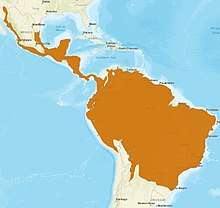 |
Oncilla L. tigrinus (Schreber, 1775)[8]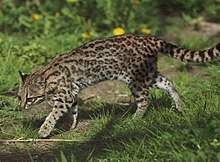 | 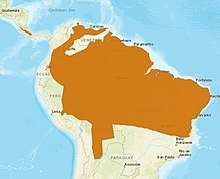 |
Kodkod L. guigna (Molina, 1782)[9] 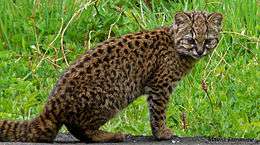 | 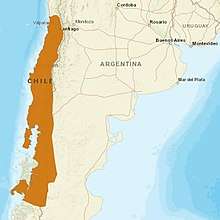 |
Pampas cat L. colocola (Molina, 1782)[9]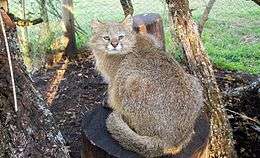 | 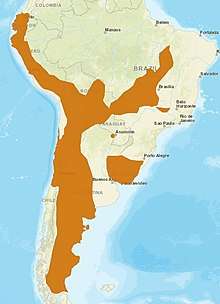 |
| Margay L. wiedii (Schinz, 1821)[10] 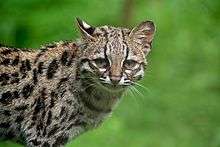 | 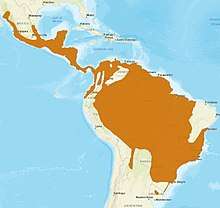 |
| Geoffroy's cat L. geoffroyi (d'Orbigny & Gervais, 1844)[11] 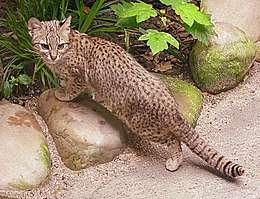 |  |
| Andean mountain cat L. jacobitus (Cornalia, 1865)[12] 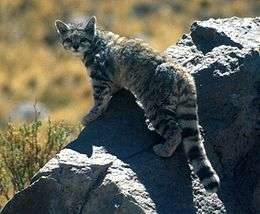 | 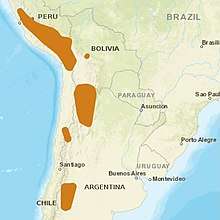 |
| Southern tigrina L. guttulus (Hensel, 1872)[13] |  |
| †L. vorohuensis (Berta, 1983)[14] | Uquian Vorohué Formation, Argentina |
References
| Wikimedia Commons has media related to Leopardus. |
| Wikispecies has information related to Leopardus |
- Wozencraft, W.C. (2005). "Genus Leopardus". In Wilson, D.E.; Reeder, D.M (eds.). Mammal Species of the World: A Taxonomic and Geographic Reference (3rd ed.). Johns Hopkins University Press. pp. 537–540. ISBN 978-0-8018-8221-0. OCLC 62265494.
- Johnson, W. E.; Eizerik, E.; Pecon-Slattery, J.; Murphy, W. J.; Antunes, A.; Teeling, E.; O'Brien, S. J. (2006). "The Late Miocene radiation of modern Felidae: A genetic assessment". Science. 311 (5757): 73–77. doi:10.1126/science.1122277. PMID 16400146.
- Reid, F. A. (2009). A Field Guide to the Mammals of Central America and Southeast Mexico (2 ed.). Oxford University Press. p. 277. ISBN 978-0-19-534323-6.
- Gray, J. E. (1842). "Descriptions of some new genera and fifty unrecorded species of Mammalia". Annals and Magazine of Natural History. 10 (65): 255–267. doi:10.1080/03745484209445232.
- Johnson, W. E.; Culver, M.; Iriarte, J. A.; Eizirik, E.; Seymour, K. L.; O'Brien, S. J. (1998). "Tracking the evolution of the elusive Andean mountain cat (Oreailurus jacobitus) from mitochondrial DNA" (PDF). Journal of Heredity. 89 (3): 227–232. doi:10.1093/jhered/89.3.227. PMID 9656464.
- Kitchener, A. C.; Breitenmoser-Würsten, C.; Eizirik, E.; Gentry, A.; Werdelin, L.; Wilting, A.; Yamaguchi, N.; Abramov, A. V.; Christiansen, P.; Driscoll, C.; Duckworth, J. W.; Johnson, W.; Luo, S.-J.; Meijaard, E.; O’Donoghue, P.; Sanderson, J.; Seymour, K.; Bruford, M.; Groves, C.; Hoffmann, M.; Nowell, K.; Timmons, Z.; Tobe, S. (2017). "A revised taxonomy of the Felidae: The final report of the Cat Classification Task Force of the IUCN Cat Specialist Group" (PDF). Cat News (Special Issue 11): 46–58.
- Linnaeus, C. (1758). "Felis pardalis". Systema naturae per regna tria naturae: secundum classes, ordines, genera, species, cum characteribus, differentiis, synonymis, locis. I (Tenth ed.). Holmiae: Laurentius Salvius. p. 42.
- Schreber, J. C. D. (1778). "Die Maragua". Die Säugethiere in Abbildungen nach der Natur, mit Beschreibungen. Erlangen: Wolfgang Walther. pp. 396–397.
- Molina, G. I. (1782). "La Guigna Felis guigna". Saggio sulla storia naturale del Chilli. Bologna: Stamperia di S. Tommaso d’Aquino. p. 295.
- Schinz, H. R. (1821). "Wiedische Katze Felis wiedii". Das Thierreich eingetheilt nach dem Bau der Thiere: als Grundlage ihrer Naturgeschichte und der vergleichenden Anatomie von dem Herrn Ritter von Cuvier. Säugethiere und Vögel, Volume 1. Stuttgart, Tübingen: Cotta. pp. 235–236.
- D'Orbigny, A.; Gervais, P. (1844). "Mammalogie: Nouvelle espèce de Felis". Extraits des Procès-verbaux des Séances. 9: 40–41.
- Cornalia, E. (1865). "Descrizione di una nuova specie del genere Felis. Felis jacobita (Corn.)". Memorie della Societá Italiana di Scienze Naturali. 1: 3–9.
- Hensel, R. (1872). "Beiträge zur Kenntniss der Säugethiere Süd-Brasiliens". Physikalische Abhandlungen der Königlichen Akademie der Wissenschaften zu Berlin (1873): 1–130.
- Berta, A. (1983). "A new species of small cat (Felidae) from the late Pliocene-early Pleistocene (Uquian) of Argentina". Journal of Mammalogy. 64 (4): 720–725. doi:10.2307/1380541. JSTOR 1380541.